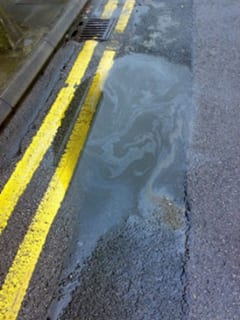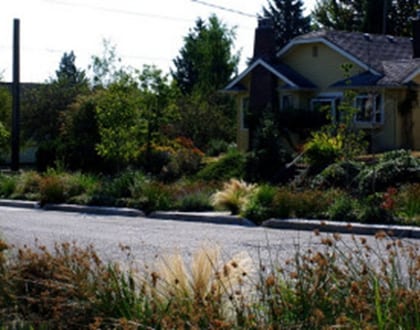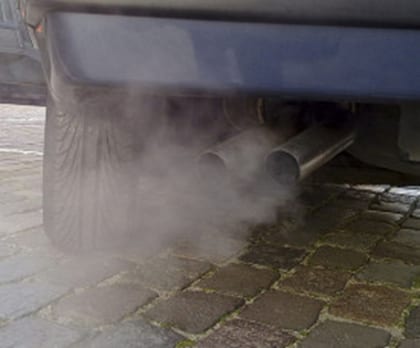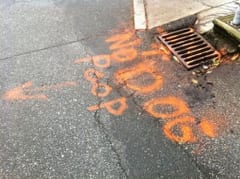Originally posted on Sightline Daily, January 22, 2013, by Sightline Fellow Lisa Stiffler, this post is part of the research project: Stormwater Solutions: Curbing Toxic Runoff.
If you’re concerned about water pollution, you’ve likely heard this message: The water that gushes off our roofs, driveways, streets, and landscaped yards is to blame for the bulk of the pollution that dirties Puget Sound and numerous Northwest waterbodies. You probably also know about the most popular stormwater solutions, including rain gardens and other green infrastructure that soak up the filthy water, cleaning it before it reaches sensitive waterways that are home to salmon, frogs, orcas, and other wildlife.
But those two ideas taken together are making some people anxious. If stormwater is the source of such devastating amounts of petroleum and heavy metals, won’t the rain garden in my front yard become a mini toxic waste site that could harm children and pets?
So what exactly is in stormwater? Washington’s Department of Ecology has identified runoff as the prime source of the mercury, lead, copper, petroleum and other dangerous chemicals getting into Puget Sound. (Table ES-1, page 13 of “Control of Toxic Chemicals in Puget Sound”)* Ecology officials estimate that more than 400 pounds of lead, for example, are being washed into Puget Sound via the stormwater that flows from residential areas.
By tonnage, though, the most significant stormwater pollutants are dirt, oil and grease, nitrogen-containing compounds and phosphorus — not the heavy metals and other stuff that’s scarier from a human health perspective (Table 15, page 205 of “Control of Toxic Chemicals in Puget Sound”)*. And for the pollutants that you wouldn’t want to come into direct contact with — lead, cancer-causing petroleum pollutants, etc. — nearly all are found in super small concentrations in stormwater.
For residential runoff sampled in the Puget Sound area, pollutants in stormwater were below levels of concern for everything except PCBs and phthalates (a family of plasticizing chemicals added to countless consumer items including lotions, perfumes, and soft plastics such as shower curtains; Table 12, page 191 of “Control of Toxic Chemicals in Puget Sound”)*, but even these were at tiny concentrations.
The problem isn’t so much with the level of pollution in a given bucket of residential runoff, but the fact that the thousands of miles of roads and countless rooftops create so danged much of it. And yet the pollution is there, so what happens to it when it soaks into a rain garden or similar green stormwater infrastructure? Does it stay in the rain garden, or percolate through it along with the water?
The fate of stormwater pollution
Scientists have answered the question of where runoff pollutants wind up through two types of experiments. They have sampled the runoff flowing into and out of actual rain gardens, and they’ve done laboratory experiments where polluted water is run through a column of soil analogous to a rain garden. (**I’ve listed many of the useful references that I’ve been able to find on stormwater pollution at the end of the post.)
The scientists found that the gardens do a great job catching metal pollutants and oil and grease — in some cases trapping more than 90 percent of the pollutants — keeping them out of streams and lakes where they harm wildlife and contaminate water for swimming, fishing, and other human uses. Rain gardens, often called bioretention systems, swales, or bioswales in the scientific literature, have a mixed record in terms of capturing bacteria based on tests done in the field.
Once the pollutants are trapped in the rain gardens, what happens to them next?
The journal Stormwater published in June a list of possible fates for pollution in stormwater systems. Here’s my adaptation of that list, edited to apply more specifically to rain gardens:
- Volatilization. Pollutants, particularly some of those associated with petroleum or oil and grease, evaporate.
- Sedimentation. In the case of standing water, heavier particles settle into the soil below.
- Adsorption. Certain dissolved pollutants stick to particles floating in the stormwater or settled into the soil.
- Absorption. Stormwater and pollutants soak deeper into the soil. Pollutants may accumulate in the soil, percolate through it with the water, or dissipate through microbial action, adsorption, or volatilization.
- Microbial action. Bacteria and other microorganisms break down pollutants in the water or soil, often into forms that are less environmentally harmful.
- Plant resistance and uptake. Decaying plant material increases adsorption and provides a good habitat for microbes that gobble pollution. Plants may also suck up pollutants from the soil through their roots, though not in large amounts.
- Filtration. Particles are captured by a filter, if one is present.
This is what can happen to the pollutants, but the question is what actually does happen? Let’s look at petroleum chemicals, metals, and bacteria in turn.
Petrol Pollution
One of the most prevalent categories of runoff pollution is oil and grease from leaking cars and spills at gas pumps, vehicle exhaust, and burning wood and fossil fuels. The contaminants include petroleum hydrocarbons, and a category of environmentally hazardous chemicals called polycyclic aromatic hydrocarbons, or PAHs.
Scientists with the University of Minnesota recently performed experiments in the field and the lab to track PAHs in stormwater systems. They collected more than 70 soil samples from more than 50 rain gardens and bioretention infrastructures in the Twin Cities. The rain gardens were capturing water from various types of land use, including parking lots, roofs, and streets. The researchers found much higher levels of petroleum hydrocarbons in the rain garden versus the non-rain garden soils, but the levels were essentially safe in both: “all soil concentrations were about one thousand times less than regulatory action levels,” the scientists reported.
And what was even more interesting was the fact that the rain garden soil contamination was much less than they expected based on the volume of petroleum hydrocarbons being flushed into the gardens with the runoff. Where were the pollutants going?
To answer that question, the scientists did experiments with naphthalene, one of the PAHs found in rain gardens. They ran naphthalene-contaminated water through simulated rain gardens and discovered that the pollutant was adsorbed by the soil, biodegraded, or taken up by plants. The bottom line: “biodegradation typically destroys the contaminant, rather than simply retaining or transforming the contaminant.”
Other studies similarly have found that bacteria in the soil of rain gardens like to dine on hydrocarbons. Research published in 2006 in the journal Water Environment Research found that 90 percent of petroleum pollutants were biodegraded by microbes in two to eight days.
And right here in the Northwest, the city of Portland’s Bureau of Environmental Services has been doing its own testing of rain gardens and other green infrastructure to track pollutants. The bureau found PAHs at all of the rain garden facilities it tested, “but typically at concentrations well below human health guidelines.” Interestingly, when they measured PAHs in non-stormwater soils next to the rain gardens, they found similar amounts of PAHs, suggesting that the pollutants are simply prevalent in many places in the urban environment.
Also keep in mind that many of the stormwater facilities tested by Portland were treating runoff coming from parking lots and roads that are being used by more cars and trucks than your average residential site, so the pollutant loads could be higher than a front-yard rain garden would likely have.
Heavy Metals
Heavy metals found in stormwater include copper, cadmium, lead, mercury, and zinc and come from a wide range of natural and human sources such as vehicle brake pads, aviation fuel, pesticides, and weathered paint. When runoff contaminated with metals streams into a rain garden, multiple studies show that the pollutants are largely adsorbed by particles in the soil and mulch. A small fraction of the metals are taken up by plants.
A 2007 study published in Chemosphere using faux stormwater contaminated with copper, lead, cadmium, and zinc in a lab simulation found that between 88 to 97 percent of the metals were captured in the soil media and up to 3 percent was trapped by plants.
But even if all the metals are being held in the rain garden, it’s still not a large volume of toxics. A 2003 study concluded that it would take about 20 years for rain garden soils soaking up runoff to reach EPA limits for the amount of heavy metals allowed in recycled sewage waste used as compost. Recent research from the University of Minnesota concluded that it would take 76 years or more for rain garden soils to reach saturation, depending on the heavy metal.
But does that mean a dog can safely dig in a rain garden, or a child can tromp through it without concern for their health (the fate of the plants put aside)?
Another way to parse the potential risk is to look at the metals in samples collected from local rain gardens and stormwater ponds. Again, the city of Portland has data from actual rain gardens and swales around the city. King and Kitsap counties in the Puget Sound region have data from the sediment scooped out of stormwater ponds. The ponds are not green infrastructure, are collecting runoff from roads that could have higher traffic than residential areas, and are not vegetated so they’re less likely to be providing some of the natural pollution treatment that occurs in rain gardens. However, the ponds can still provide meaningful information, though their pollution levels could likely be higher than what you’d expect from a rain garden in front of someone’s house that’s capturing roof and residential street runoff.
Here are charts comparing the average concentrations of some heavy metals found in Northwest stormwater ponds and rain gardens. I’ve compared the amounts to Washington’s cleanup standards under the Model Toxics Control Act. These are the cleanup standards for the soil at sites that can then be used for residential or other uses. I’ve also included the amount of pollution that is allowed in compost that can be used in Washington under the WSDA International Organic Program. Both provide benchmarks for what is considered safe to humans.
As you can see, the amount of metal contamination in the stormwater ponds and rain gardens is well below safety standards used in Washington State.
Here are the data again in a table:

Bacteria and Viruses
Microorganisms in stormwater are eliminated numerous ways. An army of tiny creatures living in the water and soil including zooplankton, protozoa, nanoflagellates, microflagellates, amoeba, and bacteria will prey upon the offending microorganisms, which include viruses and other bacteria and protozoa. Sunlight can kill or inactivate some of the microorganisms.
Despite the numerous paths to destruction, microorganisms in stormwater are tricky. Unlike pollutants such as oil and grease and metals, green stormwater infrastructure doesn’t have such a stellar track record for capturing and removing bacteria. It appears to be more readily destroyed when it’s in the water, but more likely to survive in the soil. When researchers measure the amount of bacteria entering and exiting a rain garden out in the field, sometimes the water leaves the rain garden with even higher levels of bacteria than entered it, and in other cases 90 percent of the bacteria are removed. Some experts have suggested that the waste from birds, pets, and other wildlife recontaminate the water that’s leaving the rain garden.
Of course there are bacteria and other microorganisms everywhere, all the time, and most of them don’t hurt people. So the real concern is whether the microbes washed into rain gardens pose an actual risk to humans. A lengthy 2007 study from the Water Environment Research Foundation (WERF) determined that bacteria and viruses that can make people sick have been detected in stormwater samples (Table 2-4). But when they tried to make a link between stormwater pathogens and actual cases of illness, the scientists concluded “the literature does not support widely applicable and defensible relations between pathogens and indicators in stormwater…” (page 2-13).
A Puget Sound area stormwater expert I spoke with explained the risk like this. If the water in question was coming from leaking septic systems or sewers, that waste would include human pathogens and bacteria and would be much more likely to cause illness in people. However, the bacteria found in stormwater most often comes from birds and wildlife, so the risk to humans is much lower.
Tallying the Toxics
Rain gardens and similar environmentally friendly stormwater infrastructure are being embraced worldwide because they do their job so well. They sponge up polluted runoff, keeping the foul chemicals out of the places that are home to beloved wildlife and where people like to play and fish.
The worry is that these same, very efficient rain gardens that are cropping up in our parking strips and front yards are doing their job so well that they could become residential toxic sites. But in fact are they? Not according to the research that’s available. Here’s the score on pollutants in rain gardens, in summary:
Petroleum pollutants/PAHs: Studies from the field and laboratory find that rain gardens do a great job of capturing petroleum pollution, and that the chemicals are largely eliminated when they’re destroyed by bacteria in the soil.
Heavy metals: Soil and mulch in rain gardens contain particles that will adsorb and hold metals including copper, cadmium, lead, and zinc. A small fraction of the metals are sucked into plant roots and vegetation. While metals are not degraded in rain gardens, they’re present at very low levels. When Northwest counties test for metals in the sediment that’s scooped from the bottom of stormwater ponds or rain gardens that drain parking lots and other city surfaces — material that would likely have higher levels of metals than your average residential rain garden — they found that the contamination levels were still below soil and compost standards meant to protect human health.
Bacteria and viruses: While some research has found bacteria and viruses that can cause disease in humans in stormwater, sunlight as well as other microorganisms in the runoff and soil of rain gardens can destroy the pathogens. Also, most of the microorganisms present come from animal waste and are less likely to cause illness in people.
The bottom line is that the soil in rain gardens is safe for kids and pets. That said, people are advised to wash their hands after working or playing in any soil, which can contain naturally occurring metals, fecal waste from the neighbor’s dog, or any number of compounds one wouldn’t want to ingest. And remember that while rain gardens are attractive landscape features, the plants and soil are also doing an important job, so they need to be treated with some care.
Endnotes
*In recent years, Washington regulators have tried to identify the source and volume of pollution that fouls the Salish Sea, which stretches from southern British Columbia down through Puget Sound. They’ve released multiple reports on the issue, including “Control of Toxic Chemicals in Puget Sound” and “Toxics in Surface Runoff to Puget Sound: Phase 3 Data and Load Estimates.” A great source from the first document is Table 30, which zeroes in on the specific sources of the pollutants, e.g. the top source of lead is “ammunition and hunting shot use, loss of fishing sinkers, loss of wheel weights.”
**References for pollution removal, fate, and treatment include:
- “Bioretention Technology: Overview of Current Practice and Future Needs” by Allen P. Davis et al. published in the March 2009 issue of the Journal of Environmental Engineering
- “BMP Effectiveness for Nutrients, Bacteria, Solids, Metals, and Runoff Volume,” by Jonathan E. Jones et al. published in the March-April 2012 issue of Stormwater
- “Capture and Release of Pollutants by Rain Gardens” by Joel G. Morgan et al. from the November 2011 issue of the Updates Newsletter from the University of Minnesota
- “Contamination of Soil and Groundwater Due to Stormwater Infiltration Practices: A Literature Review” from Peter T. Weiss et al. and published in June 2008 as a project report from the University of Minnesota
- “Development of a Protocol for Risk Assessment of Microorganisms in Separate Stormwater Systems” by Adam W. Olivieri et al. and published in 2007 by the Water Environment Research Foundation
- “Investigating Stormwater Hydrocarbon Fate and Biodegradation in Bioretention Areas” by Gregory H. LeFevre et al. from the April 2012 issue of the Updates Newsletter from the University of Minnesota
- “Review of Bioretention System Research and Design: Past, Present, and Future” by Audrey Roy-Poirier et al. published in the September 2010 issue of the Journal of Environmental Engineering
- “Sustainable Oil and Grease Removal from Synthetic Stormwater Runoff Using Bench-Scale Bioretention Studies” by Eunyoung Hong et al. from the February 2006 issue of Water Environment Research
- The Performance of Grassed Swales as Infiltration and Pollution Prevention Practices: A Literature Review” from Peter T. Weiss et al. and published in November 2010 through the University of Minnesota
- “2010 Stormwater Management Facility Monitoring Report” by the City of Portland’s Bureau of Environmental Services, Tim Kurtz et al., and published in December 2010
From “Are Rain Gardens Mini Toxic Cleanup Sites?” by Lisa Stiffler, Copyright 2013, Sightline Institute; used with permission.
About the Author
Lisa Stiffler, a Journalism fellow, writes about pressing issues in the Northwest, like polluted stormwater that runs into Puget Sound, or harmful BPA in baby products. Before joining the Sightline team, Stiffler was a reporter at the Seattle Post-Intelligencer for ten years, most of them spent covering environmental issues. She may be reached at lis@sightlin.org.





